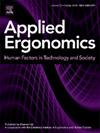Takeover and non-driving related task performance in conditional automated driving: EEG and behavior Parameters interaction
IF 3.4
2区 工程技术
Q2 ENGINEERING, INDUSTRIAL
引用次数: 0
Abstract
In this study, a conditional automated driving scenario is simulated using virtual reality (VR) technology to explore whether office works presented through augmented reality (AR) affect task and takeover performance, and the neural mechanism was revealed. Sixty-four participants were recruited and their electroencephalography (EEG) was used to measure the brain activities. The results indicated that non-driving-related tasks (NDRTs) requiring higher internal attention focus resulted in poorer task and takeover performance. The alpha power decline magnitude in the parietotemporal (PT) was positively correlated with the takeover time; and the greater the alpha power decline in the right centroparietal (CP) hemisphere, the worse is the participants’ memory quality for NDRTs. The ventral attention network (VAN) and right parietal cortex, which are active during working memory, are more likely to explain these findings. The results can provide suggestions for the design of AR-ADS and help improve the safety in L3 driving automation systems.
有条件自动驾驶中的接管与非驾驶相关任务的表现:脑电图与行为参数的相互作用
本研究利用虚拟现实(VR)技术模拟有条件自动驾驶场景,探讨通过增强现实(AR)呈现的办公作品是否会影响任务和接管性能,并揭示其神经机制。研究共招募了 64 名参与者,并使用脑电图(EEG)测量他们的大脑活动。结果表明,与驾驶无关的任务(NDRTs)需要更高的内部注意力集中,这导致任务和接管表现较差。顶颞叶(PT)的α功率下降幅度与接管时间呈正相关;右顶叶半球(CP)的α功率下降幅度越大,参与者对NDRT的记忆质量越差。在工作记忆期间活跃的腹侧注意网络(VAN)和右顶叶皮层更有可能解释这些发现。研究结果可为AR-ADS的设计提供建议,并有助于提高L3自动驾驶系统的安全性。
本文章由计算机程序翻译,如有差异,请以英文原文为准。
求助全文
约1分钟内获得全文
求助全文
来源期刊

Applied Ergonomics
工程技术-工程:工业
CiteScore
7.50
自引率
9.40%
发文量
248
审稿时长
53 days
期刊介绍:
Applied Ergonomics is aimed at ergonomists and all those interested in applying ergonomics/human factors in the design, planning and management of technical and social systems at work or leisure. Readership is truly international with subscribers in over 50 countries. Professionals for whom Applied Ergonomics is of interest include: ergonomists, designers, industrial engineers, health and safety specialists, systems engineers, design engineers, organizational psychologists, occupational health specialists and human-computer interaction specialists.
 求助内容:
求助内容: 应助结果提醒方式:
应助结果提醒方式:


